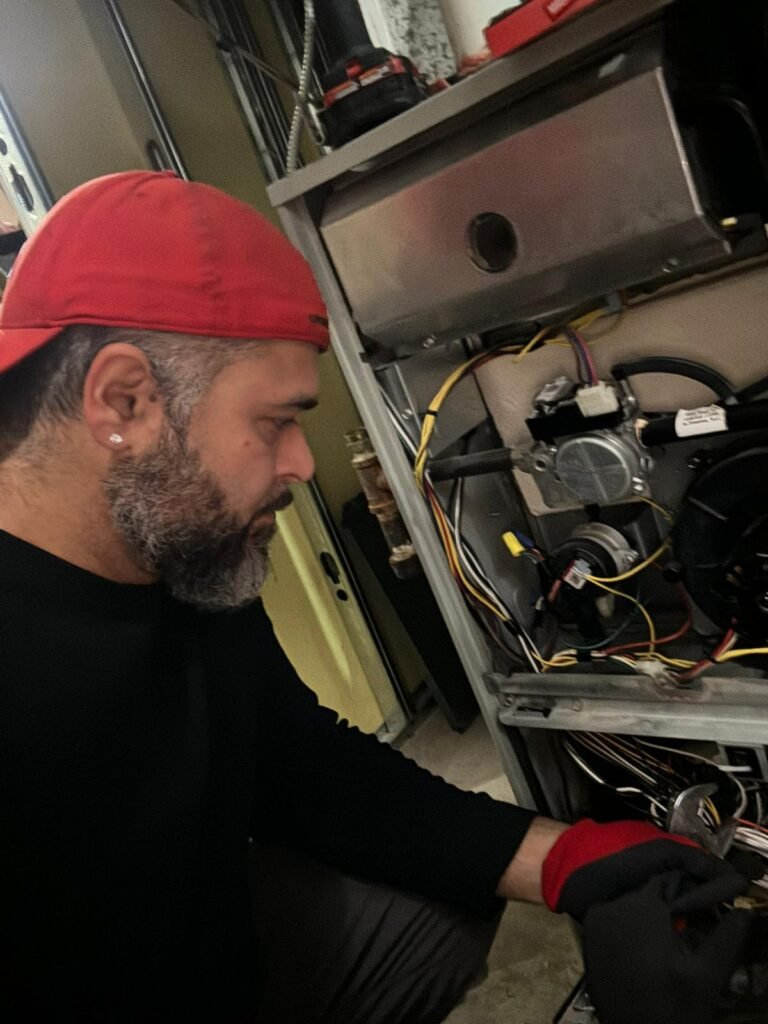Install Furnace
FURNACE INSTALLATION SERVICES
Your trusted local technician with over 20 years of experience.

Professional Installation Services
Expert Furnace Installation Services for Your Home
A furnace is a key component in keeping your home warm and comfortable during colder months. Installing a new furnace, or replacing an old one, requires professional expertise to ensure safety, efficiency, and long-term reliability. In this guide, we’ll walk you through the benefits of professional furnace installation, the different types of furnaces, and what to expect during the installation process.
Why You Need Professional Furnace Installation
Ensuring Proper Installation for Maximum Efficiency
A professionally installed furnace will run more efficiently, saving you money on energy bills. Proper installation ensures that your furnace is set up for optimal performance, helping it heat your home more effectively.
Avoiding Safety Hazards
Installing a furnace involves working with gas or electrical connections, which can pose safety risks if not handled correctly. Professional technicians are trained to handle these connections safely, reducing the risk of gas leaks, carbon monoxide exposure, or electrical hazards.
Meeting Local Building Codes
Furnace installation requires compliance with local building codes and safety regulations. Hiring professionals ensures that your new furnace is installed in accordance with these laws, avoiding any potential fines or future issues when selling your home.
Maintaining Warranty Coverage
Most furnace manufacturers require professional installation to maintain the warranty. By choosing certified technicians, you protect your warranty and ensure that your investment is safeguarded.
Types of Furnaces for Installation
Gas Furnaces
Gas furnaces are one of the most popular options for home heating, as they are highly efficient and cost-effective in areas with low gas prices. A professional technician will ensure that your gas furnace is properly connected to your gas line and vented safely.
Electric Furnaces
Electric furnaces are easy to install and do not require gas lines, making them an ideal option for homes without access to natural gas. While they may have higher energy costs, professional installation ensures they are optimized for efficiency.
Oil Furnaces
Oil furnaces are less common but still a reliable option in areas where natural gas or electricity is not readily available. Proper installation of oil furnaces requires expert knowledge to ensure that the fuel lines and storage tanks are safely installed.
Dual Fuel Systems
Dual fuel systems combine a gas furnace with a heat pump for greater energy efficiency. A professional can help you decide if this system is right for your home, and ensure both systems are installed and integrated properly.
The Furnace Installation Process
Initial Consultation and Assessment
Before installation, a technician will assess your home’s heating needs. This includes considering the size of your home, the climate, and your budget. The technician will help you choose the right furnace model for your specific needs.
Selecting the Right Size Furnace
One of the most important aspects of furnace installation is selecting the correct size. A furnace that’s too small won’t heat your home effectively, while an oversized unit will cycle on and off too frequently, wasting energy. Professionals will calculate the right size for your home’s square footage and insulation.
Installation Day: What to Expect
On the day of installation, your technician will remove the old furnace (if applicable), prepare the space for the new unit, and install the furnace according to manufacturer guidelines. This includes connecting the furnace to the appropriate power source, ensuring proper ventilation, and testing the system to ensure it works efficiently.
Post-Installation Inspection and Testing
After installation, the technician will perform a thorough inspection to ensure that the furnace is working properly and safely. This includes checking all connections, testing the thermostat, and ensuring that the system is distributing heat evenly throughout your home.
Benefits of Installing a New Furnace
Improved Heating Efficiency
A new furnace is much more efficient than older models, especially if your current furnace is more than 10 years old. A professional installation ensures that your new furnace operates at peak efficiency, keeping your home warm while using less energy.
Lower Energy Bills
With a more efficient furnace, you’ll notice a significant reduction in your energy bills. New furnaces are designed to use less fuel or electricity while providing the same amount of heat, resulting in long-term savings on heating costs.
Enhanced Comfort and Air Quality
New furnaces provide more consistent heating, ensuring that your home stays warm and comfortable throughout the winter. Additionally, modern furnaces often come with advanced air filtration systems, improving your home’s air quality by reducing dust, allergens, and pollutants.
Reduced Repair Costs
Older furnaces are more prone to breakdowns and require frequent repairs. By installing a new furnace, you reduce the likelihood of costly repairs and enjoy peace of mind knowing that your system is reliable.
Furnace Maintenance Tips After Installation
Schedule Annual Inspections
Regular maintenance is key to keeping your furnace running efficiently. Schedule annual inspections with a certified technician to check for any potential issues and ensure your system is in top condition.
Replace Air Filters Regularly
Dirty air filters can reduce your furnace’s efficiency and cause it to work harder than necessary. Replace the air filters every 1-3 months to keep your furnace running smoothly and improve your home’s air quality.
Keep Vents and Registers Clean
Blocked vents and registers can restrict airflow, causing your furnace to overwork. Make sure that your home’s vents are clear of furniture, curtains, and debris to maintain proper airflow and heating efficiency.
Monitor Your Energy Bills
After installing a new furnace, keep an eye on your energy bills. A sudden spike in costs could indicate an issue with your furnace, such as a malfunctioning component or poor airflow. Contact a technician if you notice any unusual changes in energy consumption.
How to Choose a Professional Furnace Installer
Look for Licensing and Certification
Always hire licensed and certified HVAC technicians to install your furnace. Certified professionals have the expertise to ensure a safe and efficient installation that complies with local codes and regulations.
Check for Experience and Reviews
When choosing an installer, look for a company with a proven track record of successful furnace installations. Read customer reviews and ask for references to ensure that you’re working with a reputable team.
Compare Quotes and Services
Before deciding on an installer, request quotes from multiple companies to compare pricing and services. Make sure the quote includes all aspects of the installation, including labor, materials, and any necessary permits.
Ask About Warranty and Maintenance Plans
Reputable installation companies will offer warranties on their work as well as the furnace itself. Inquire about maintenance plans that include annual inspections and tune-ups to keep your furnace running efficiently for years to come.
Conclusion: Invest in Professional Furnace Installation for Comfort and Efficiency
Installing a new furnace is an investment in your home’s comfort and energy efficiency. With professional furnace installation, you ensure that your system is set up to perform safely and effectively for years to come. From selecting the right furnace to expert installation and post-installation testing, certified technicians will help you get the most out of your new heating system.
Trust the experts to install your furnace and enjoy a warm, energy-efficient home all winter long.
FAQs
What factors should I consider when selecting a new furnace for my home?
When selecting a new furnace, consider factors such as fuel type (gas, electric, oil), efficiency ratings, size, capacity, and any additional features or upgrades you may desire. Our team can provide expert guidance to help you make an informed decision.
Can you help me determine the right size and capacity for my new furnace installation?
Yes, our technicians will conduct a thorough assessment of your home’s size, insulation, layout, and heating needs to recommend the appropriate size and capacity for your new furnace, ensuring optimal performance and efficiency.
Do you offer post-installation support or assistance if I have questions or concerns about my new furnace?
Absolutely! We value our customers’ satisfaction, and our support doesn’t end after installation. If you have any questions or concerns about your new furnace, don’t hesitate to contact us. We’re here to provide ongoing support and assistance to ensure your complete satisfaction.
What factors do you consider when determining the best location for installing the new furnace?
When determining the best location for installing a new furnace, our technicians consider factors such as accessibility for maintenance, proximity to existing ductwork and ventilation systems, safety regulations, and the manufacturer’s installation guidelines. We’ll work with you to find the most suitable location that ensures optimal performance and efficiency for your new furnace.
